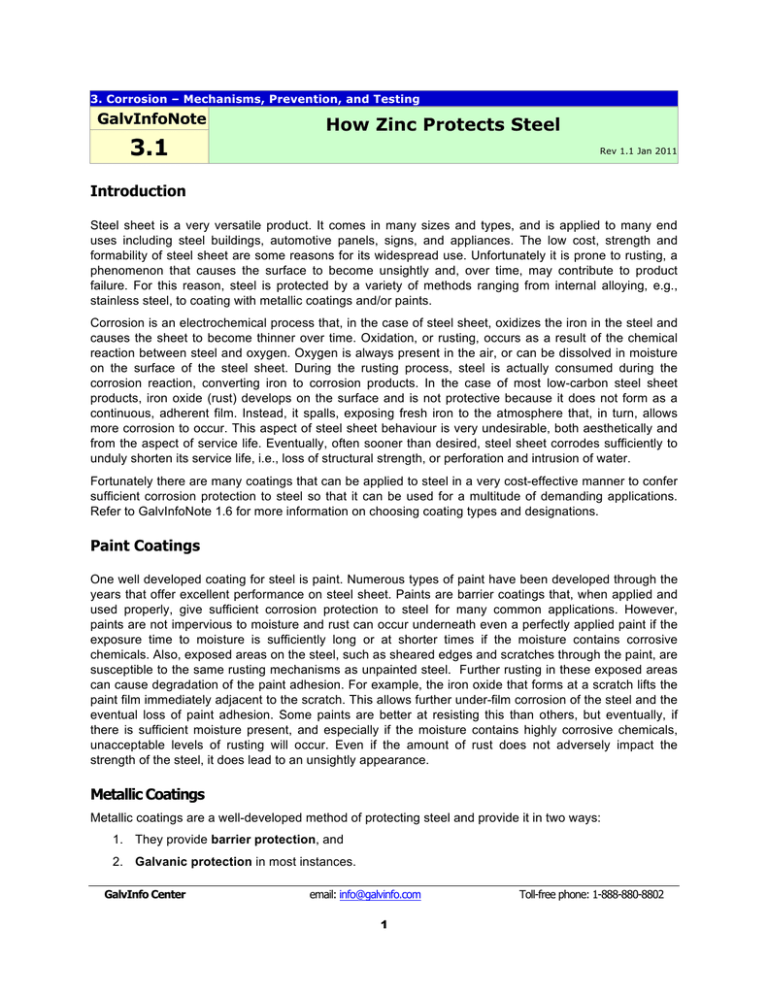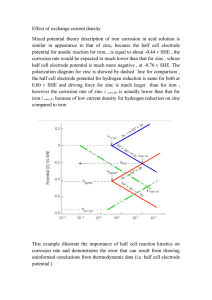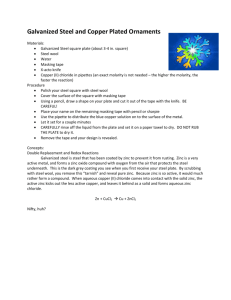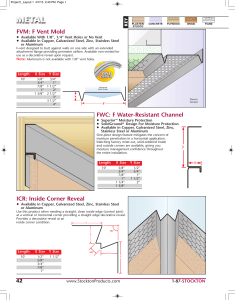How Zinc Protects Steel
advertisement

3. Corrosion – Mechanisms, Prevention, and Testing GalvInfoNote 3.1 How Zinc Protects Steel Rev 1.1 Jan 2011 Introduction Steel sheet is a very versatile product. It comes in many sizes and types, and is applied to many end uses including steel buildings, automotive panels, signs, and appliances. The low cost, strength and formability of steel sheet are some reasons for its widespread use. Unfortunately it is prone to rusting, a phenomenon that causes the surface to become unsightly and, over time, may contribute to product failure. For this reason, steel is protected by a variety of methods ranging from internal alloying, e.g., stainless steel, to coating with metallic coatings and/or paints. Corrosion is an electrochemical process that, in the case of steel sheet, oxidizes the iron in the steel and causes the sheet to become thinner over time. Oxidation, or rusting, occurs as a result of the chemical reaction between steel and oxygen. Oxygen is always present in the air, or can be dissolved in moisture on the surface of the steel sheet. During the rusting process, steel is actually consumed during the corrosion reaction, converting iron to corrosion products. In the case of most low-carbon steel sheet products, iron oxide (rust) develops on the surface and is not protective because it does not form as a continuous, adherent film. Instead, it spalls, exposing fresh iron to the atmosphere that, in turn, allows more corrosion to occur. This aspect of steel sheet behaviour is very undesirable, both aesthetically and from the aspect of service life. Eventually, often sooner than desired, steel sheet corrodes sufficiently to unduly shorten its service life, i.e., loss of structural strength, or perforation and intrusion of water. Fortunately there are many coatings that can be applied to steel in a very cost-effective manner to confer sufficient corrosion protection to steel so that it can be used for a multitude of demanding applications. Refer to GalvInfoNote 1.6 for more information on choosing coating types and designations. Paint Coatings One well developed coating for steel is paint. Numerous types of paint have been developed through the years that offer excellent performance on steel sheet. Paints are barrier coatings that, when applied and used properly, give sufficient corrosion protection to steel for many common applications. However, paints are not impervious to moisture and rust can occur underneath even a perfectly applied paint if the exposure time to moisture is sufficiently long or at shorter times if the moisture contains corrosive chemicals. Also, exposed areas on the steel, such as sheared edges and scratches through the paint, are susceptible to the same rusting mechanisms as unpainted steel. Further rusting in these exposed areas can cause degradation of the paint adhesion. For example, the iron oxide that forms at a scratch lifts the paint film immediately adjacent to the scratch. This allows further under-film corrosion of the steel and the eventual loss of paint adhesion. Some paints are better at resisting this than others, but eventually, if there is sufficient moisture present, and especially if the moisture contains highly corrosive chemicals, unacceptable levels of rusting will occur. Even if the amount of rust does not adversely impact the strength of the steel, it does lead to an unsightly appearance. Metallic Coatings Metallic coatings are a well-developed method of protecting steel and provide it in two ways: 1. They provide barrier protection, and 2. Galvanic protection in most instances. GalvInfo Center email: info@galvinfo.com 1 Toll-free phone: 1-888-880-8802 GalvInfoNote 3.1 Rev 1.1 Jan 2011 These protection mechanisms are described below. Barrier Protection The main mechanism by which galvanized coatings protect steel is by providing an impervious barrier that does not allow moisture to contact the steel, since without moisture (electrolyte) there is no corrosion. The nature of the galvanizing process ensures that the metallic zinc coating has excellent adhesion, abrasion, and corrosion resistance. Galvanized coatings will not degrade (crack, blister, and peel) as with other barrier coatings such as paint. However, zinc is a reactive material and will corrode and erode slowly. For this reason, the protection offered by a galvanized coating is proportional to its thickness and to the corrosion rate. It is therefore important to understand zinc's corrosion mechanism and what factors affect the rate. Freshly exposed galvanized steel reacts with the surrounding atmosphere to form a series of zinc corrosion products. In air, newly exposed zinc reacts with oxygen to form a very thin, tenacious zinc oxide layer. When moisture is present, zinc reacts with water, resulting in the formation of zinc hydroxide. The final corrosion product is zinc carbonate, which forms from zinc hydroxide reacting with carbon dioxide in the air. Zinc carbonate is a thin, tenacious, and stable (insoluble in water) layer that provides protection to the underlying zinc, and is the primary reason for its low corrosion rate in most environments. Refer to GalvInfoNote 3.2 for more information on the films that form on zinc. Other metallic coatings, such as aluminum, also provide good barrier protection for steel sheet. Why is this the case with aluminum? Similar to steel and zinc, aluminum reacts in air to form an oxide film on its surface. However, contrary to the behaviour of iron oxide, and similar to what happens with zinc, the aluminum oxide film that forms does not spall off, and remains as an intact, very tightly adhering film on the surface of the aluminum. By preventing exposure of fresh aluminum to air and moisture this intact film stops further corrosion of the underlying aluminum. The oxide remains as a stable non-corroding film. Galvanic (Cathodic) Protection The second shielding mechanism is zinc's ability to galvanically protect steel. When base steel is exposed, such as at a cut edge or scratch, the steel is cathodically protected by the sacrificial corrosion of the zinc coating. This occurs because zinc is more electronegative (more reactive) than steel in the galvanic series, as shown below. Galvanic Series of Metals and Alloys Corroded End - Anodic (Electronegative) Magnesium Zinc Aluminum Cadmium Iron or Steel Stainless Steels (active) Lead Tin Copper Gold (Electropositive) Protected End - Cathodic or most noble Note: Any one of these metals and alloys will theoretically corrode while protecting any other that is lower in the series as long as both form part of an electrical circuit. GalvInfo Center email: info@galvinfo.com 2 Toll-free phone: 1-888-880-8802 GalvInfoNote 3.1 Rev 1.1 Jan 2011 In practice, this means that a zinc coating will not be undercut by rusting steel because the steel adjacent to the zinc coating cannot corrode. Any exposure of the underlying steel, due to severe coating damage or a cut edge, will not result in corrosion of the steel until the adjacent zinc has been consumed. Unless relatively large areas of steel are exposed there is minimal effect on the overall service life of the coating. The distance over which the galvanic protection of zinc is effective depends on the environment. When completely and continuously wetted, especially by a strong electrolyte, e.g., seawater, relatively large areas of exposed steel will be protected as long as any zinc remains. In air, where the electrolyte is only superficial or discontinuously present (such as from dew or rain), smaller areas of bare steel are protected. The “throwing power” is nominally about 0.125 in [3.2 mm], although this can vary significantly with the type of atmosphere. If the coating is consumed, why use it? In the case of a zinc coating, the rate of corrosion that it undergoes while protecting steel is considerably lower than that of the steel (by at least a factor of 10). In this way, a thin coating of zinc can protect steel for a long time. For example, in a rural atmosphere, where the number and concentration of pollutants in the air is generally quite low, zinc might corrode at a rate of 0.04 mil/year [1.0 µm/year], while low-carbon steel in this same environment might corrode at a rate 10 times as high (0.4 mil/year [10 µm/year or]), or even higher. The primary reason for the reduced rate of zinc corrosion versus the rate for steel is that, as it corrodes, zinc forms an adherent, protective oxide/carbonate film on its surface similar to the oxide film on the surface of aluminum. This film helps to prevent contact between the environment and fresh zinc, and the rate of corrosion is kept low. Recall that steel typically does not form a protective film in that the oxide layer spalls, constantly exposing fresh iron to the environment. The film that forms on the surface of zinc is not as protective as the aluminum oxide film on the surface of metallic aluminum. One reason is that zinc oxide/carbonate is susceptible to dissolution if the moisture is sufficiently acidic. This is good and bad. It is good in that, if the oxide film were totally protective, the zinc would no longer offer galvanic protection to the steel at exposed areas. Rusting of steel would therefore occur at scratches and other exposed areas. The downside of the somewhat incompleteness of protection of the oxide film on a galvanized sheet is that the coating does corrode and is eventually consumed. Other Galvanically Protective Coatings Among the commercially available metallic-coated steel sheet products, zinc (galvanize) offers the most galvanic protection. Zinc-5% aluminum alloy coated behaves similarly with respect to the level of galvanic protection that it provides. Steel sheet with a 55% aluminum-zinc alloy coating offers somewhat reduced galvanic protection versus a galvanized or Zn-5% Al alloy coating. What does this mean about the relative performance of these products? As with most things in life, everything comes with a price. Galvanically protective coatings are consumed by corrosion eventually. That is why a galvanized sheet has a definite life span, i.e., time before corrosion of the steel begins. Thus, the amount of zinc applied to the steel during manufacture, described as the coating weight [mass], is important to the life of the product. Coating weight (mass) is expressed using terminology such as G60 [Z180], G90 [Z275], G200 [Z600] etc. per ASTM Specification A653/A653M. 2 2 G60 [Z180] means that the coating weight [mass] is 0.60 oz/ft [180 g/m ], minimum (total coating on both sides of the sheet). This coating weight [mass] can be translated into thickness; a G60 [Z180] coating of zinc is about 0.00055 in. [0.014 mm] per side of the sheet. For a galvanized coating, the rate of corrosion is typically linear in most environments, i.e., twice the coating thickness translates to twice the “life”. Of course, different environments are more or less GalvInfo Center email: info@galvinfo.com 3 Toll-free phone: 1-888-880-8802 GalvInfoNote 3.1 Rev 1.1 Jan 2011 corrosive than others, so that the “life” of the coating varies considerably for different “environment types”. This behaviour is shown in the following figure. Industrial atmosphere Marine atmosphere Thickness or mass loss Rural atmosphere Increasing time of exposure Note: for a quantitative version of this chart refer to GalvInfoNote 1.6 These three types of atmospheres all exhibit different rates of corrosion, but the behaviour is linear. For example, a G90 [Z275] coating will exhibit a longer life in a rural atmosphere than in a polluted industrial atmosphere, but still the rate is linear in both environments. Twice the coating thickness or coating mass will give twice the coating life. Now, consider the life of a 55% Al-Zn alloy coating, a product that clearly exhibits less galvanic protection than a galvanized coating, at least after some time of exposure. A 55% Al-Zn alloy coating, being less galvanic in nature, is less reactive. This is one reason why the life of this coated product is considerably longer (in most cases) than a galvanized coating of comparable thickness. This behaviour of a 55% Al-Zn alloy coating is the reason why it is being used successfully for bare roofing applications. Of course, there are applications where the highly galvanic nature of zinc is desired. Also, there are other considerations that need to be taken into account when selecting a product for a specific application. Life of a Galvanized Coating in Different Environments We have established that a galvanized coating protects steel: 1. By two mechanisms – barrier protection and galvanic protection, and 2. By a linear rate of corrosion for any specific environment type, and 3. For considerably different time periods depending on the specific environment What is the life of the product in specific applications? The answer to this question is very complex. There are textbooks written on this subject. Two excellent references are: GalvInfo Center email: info@galvinfo.com 4 Toll-free phone: 1-888-880-8802 GalvInfoNote 3.1 Rev 1.1 Jan 2011 Corrosion Resistance of Zinc and Zinc Alloys, by Frank C. Porter, published Marcel Decker, Inc., 1994 Corrosion and Electrochemistry of Zinc, by Xiaoge Gregory Zhang, published by Plenum Press, 1996 The following table contains a small amount of the data in the book compiled by Frank Porter. Location/Environment Type Corrosion Rate, µm/year for 5 years State College, PA/rural South Bend, In/semi-rural Middletown, OH/semi-industrial Kearny, NJ/Industrial-urban Kure Beach, NC/marine Daytona Beach, FL/marine Montreal, Quebec/industrial-marine Esquimalt, BC/rural-marine Sheffield, Great Britain/industrial 1.0 1.9 1.3 4.5 1.1 1.8 3.5 0.5 5.1 These data are for exposure in the atmosphere. There are many other applications for galvanized sheet in which the corrosion rate might be different. These include: contacts with water, buried in soil, contact with concrete, sheltered areas on buildings such as under eaves, ductwork inside buildings, etc. For each of these and other applications, the corrosion performance depends on many of specific aspects of the application. For example, when used in contact with concrete, how often does the concrete/galvanized sheet interface get wet? When buried in soil, what is the pH of the soil and the soil permeability, the oxygen content, etc? When used for ductwork, does the product experience condensation periodically or on a regular basis? Are there pollutants in the condensate? Many of these types of questions are answered in the referenced textbooks. As explained in GalvInfoNote 1.6, it should be emphasized that much of the zinc corrosion data given in the above references was generated in the 1950–1970 era. Aggressive pollutants such as sulfur dioxide th are much declined from their higher levels of the mid 20 century. The service life of galvanize in, say, urban industrial areas is now longer than it was 30 to 50 years ago. On the other hand, corrosion rates in marine environments are not so much changed, since the rate of zinc loss is governed more by the amount of deposited sea salt than airborne pollutants. The life expectancy of galvanize sheet is now more reliably determined using the Zinc Coating Life Predictor (ZCLP). This software was developed by Gregory Zhang of Teck Cominco, and can be found at www.galvinfo.com in the GalvInfo Library – Additional Information section. It is applicable to all zinc-coated steel; that is, coatings composed of zinc exclusively. It does not apply to zinc/aluminum or aluminum/zinc coatings. It performs calculations based on statistical models, neural network technology and an extensive worldwide corrosion database. The environmental input data obtained by the AGA was from the World Wide Web. The calculated corrosion rates used to generate the service life chart in Figure 1 of GalvInfoNote 1.6 are based on the ZCLP model, and are an average for six different North American cities in each of the five climate categories. It is important to emphasize that corrosion rates given by the ZCLP are calculations based on models that use environmental data, and are not based on actual measured corrosion rates in the respective environments. GalvInfo Center email: info@galvinfo.com 5 Toll-free phone: 1-888-880-8802 GalvInfoNote 3.1 Rev 1.1 Jan 2011 Summary Hopefully, this discussion helps explain some of the issues associated with the effect of coatings on the corrosion behaviour of coated-steel sheet products. This field of technology has many aspects that cannot be explained in a brief article such as this. If you have additional questions on this very extensive subject, please contact the GalvInfo Center. Refer to GalvInfoNote 1.6 for more information on choosing coating types and designations. Another source of information on how zinc protects steel can be found in ASM Metals Handbook Vol. 13B Corrosion: Materials, 2005, pp. 402-417,available at: http://asmcommunity.asminternational.org/portal/site/www/ Copyright 2011 – IZA Disclaimer: Articles, research reports, and technical data are provided for information purposes only. Although the publishers endeavor to provide accurate, timely information, the International Zinc Association does not warrant the research results or information reported in this communication and disclaims all liability for damages arising from reliance on the research results or other information contained in this communication, including, but not limited to, incidental or consequential damages. GalvInfo Center email: info@galvinfo.com 6 Toll-free phone: 1-888-880-8802




